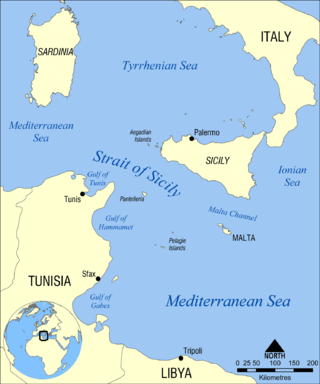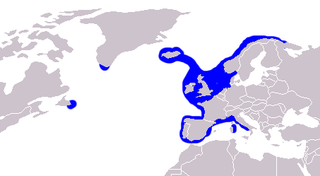Biota
It is important to note that the laminariae of low depth (Sacchoryza polyschides), or the deep populations of Laminaria ochroleuca , and the associated plant communities are dependent on the physical and biological characteristics of the substrate. In order to complete their life-cycle, these organisms demand a solid substrate already colonized by coralline algae, in the absence of which colonization cannot take place.
The Strait of Messina, bordered between the two basins of the Mediterranean, the West and the East, is an important point for migration of the species that are found in each. In this area planktonic and benthic communities from both or the Atlantic Ocean merge.
Benthic species of importance are Pilumnus inermis, previously considered to be exclusively Atlantic; Errina aspera (Hydrozoa), a famous endemic species of the Strait of Messina, on which lives a parasitic sea snail ( Pedicularia sicula ); found between 80 and 110 m. Other species are Ophiactis balli, the crustaceans Parthenope expansa and Portunus pelagicus and the giant barnacle, Pachylasma giganteum. Great biological and ecological importance is also ascribed to the already cited Laminariales of the Strait Sacchoryza polyschides and Laminaria ochroleuca, of Albunea carabus and to the conspicuous Pinna nobilis , the calcareous presence of red algae and immense prairies of Posidonia oceanica which covers wide areas and has a wide vertical distribution.
Of extreme importance because they are found only in small areas elsewhere in the Mediterranean are Phyllariopsis brevipes , Phyllariopsis purpurascens , Desmarestia dresnayi, Desmarestia ligulata , Desmarestia ramose and Cryptopleura species.
From the faunistic point of view the Strait of Messina is considered a "Paradise of the Zoologist" for the enormous biodiversity that characterizes it. The species of benthic invertebrates are those which arise greater interest since they are enriched by a great variety of forms and colours due to the abundance of Cnidaria (sea anemones, madrepore and corals). A clear example is the "forest" of yellow and red Paramuricea clavata . These, adding to the substrate, create an ideal benthic environment to accommodate numerous other species.

The Mediterranean Sea is a sea connected to the Atlantic Ocean, surrounded by the Mediterranean Basin and almost completely enclosed by land: on the north by Southern Europe and Anatolia, on the south by North Africa, on the east by the Levant in West Asia, and on the west almost by the Morocco–Spain border. The Mediterranean has played a central role in the history of Western civilization. Geological evidence indicates that around 5.9 million years ago, the Mediterranean was cut off from the Atlantic and was partly or completely desiccated over a period of some 600,000 years during the Messinian salinity crisis before being refilled by the Zanclean flood about 5.3 million years ago.

Reggio di Calabria, commonly and officially referred to as Reggio Calabria, or simply Reggio by its inhabitants, is the largest city in Calabria as well as the seat of the Regional Council of Calabria. It has an estimated population between 150,000 and 200,000 and is the twenty-first most populous city in Italy, after Modena and other Italian cities, and the 100th most populated city in Europe. Reggio Calabria is located near the center of the Mediterranean and is known for its climate, ethnic and cultural diversity. It is the third economic centre of mainland Southern Italy. About 560,000 people live in the metropolitan area, recognised in 2015 by Italy as a metropolitan city. Sadly, it holds the record of the worst city in terms of quality of life for environmental and cultural parameters, ranking among the worst Italian cities for quality of life.

The Strait of Messina is a narrow strait between the eastern tip of Sicily and the western tip of Calabria in Southern Italy. It connects the Tyrrhenian Sea to the north with the Ionian Sea to the south, within the central Mediterranean. At its narrowest point, between Torre Faro and Villa San Giovanni, it is 3.1 km (1.9 mi) wide. At the city of Messina, it is 5.1 km (3.2 mi) wide. The strait's maximum depth is about 250 m (820 ft).

The swordfish, also known as the broadbill in some countries, are large, highly migratory predatory fish characterized by a long, flat, pointed bill. They are a popular sport fish of the billfish category, though elusive. Swordfish are elongated, round-bodied, and lose all teeth and scales by adulthood. These fish are found widely in tropical and temperate parts of the Atlantic, Pacific, and Indian Oceans, and can typically be found from near the surface to a depth of 550 m (1,800 ft), and exceptionally up to depths of 2,234 m. They commonly reach 3 m (10 ft) in length, and the maximum reported is 4.55 m in length and 650 kg (1,430 lb) in weight.

The Strait of Sicily is the strait between Sicily and Tunisia. The strait is about 145 kilometres (90 mi) wide and divides the Tyrrhenian Sea and the western Mediterranean Sea, from the eastern Mediterranean Sea. The maximum depth is 316 meters (1,037 ft). The island of Pantelleria lies in the middle of the strait.

The province of Reggio Calabria was a province in the Calabria region of Italy. It was the southernmost province in mainland Italy and is separated from the island of Sicily by the Strait of Messina. The capital was the city of Reggio.

The Strait of Messina Bridge is a planned 3.6-kilometre suspension bridge across the Strait of Messina, connecting Torre Faro in Sicily with Villa San Giovanni in the Italian Peninsula.

Enrico Hillyer Giglioli was an Italian zoologist and anthropologist.

The common ling, also known as the white ling or simply the ling, is a large member of the family Lotidae, a group of cod-like fishes. It resembles the related rocklings, but it is much larger and has a single barbel. This species is unrelated to the pink ling, Genypterus blacodes, from the Southern Hemisphere. The common ling is found in the northern Atlantic, mainly off Europe, and into the Mediterranean Basin. It is an important quarry species for fisheries, especially in the northeastern Atlantic, although some doubts exist as to the sustainability of the fisheries. As an edible species, it is eaten fresh, frozen, or dried, but also preserved in lye, while the roe is a delicacy in Spain.

The European seabass, also known as the branzino, European bass, sea bass, common bass, white bass, capemouth, white salmon, sea perch, white mullet, sea dace or loup de mer, is a primarily ocean-going fish native to the waters off Europe's western and southern and Africa's northern coasts, though it can also be found in shallow coastal waters and river mouths during the summer months and late autumn. It is one of only six species in its family, Moronidae, collectively called the temperate basses.

A devastating earthquake occurred on 28 December 1908 in Sicily and Calabria, southern Italy with a moment magnitude of 7.1 and a maximum Mercalli intensity of XI (Extreme). The epicentre was in the Strait of Messina which separates Sicily from the Italian mainland. The cities of Messina and Reggio Calabria were almost completely destroyed and between 75,000 and 82,000 people died, making it the deadliest earthquake in the history of Europe.

The fauna of Italy comprises all the animal species inhabiting the territory of the Italian Republic and its surrounding waters. Italy has the highest level of faunal biodiversity in Europe, with over 57,000 species recorded, representing more than a third of all European fauna. This is due to various factors. The Italian peninsula is in the centre of the Mediterranean Sea, forming a corridor between central Europe and North Africa, and it has 8,000 km (5,000 mi) of coastline. Italy also receives species from the Balkans, Eurasia, and the Middle East. Italy's varied geological structure, including the Alps and the Apennines, Central Italian woodlands, and Southern Italian Garigue and Maquis shrubland, also contribute to high climate and habitat diversity.

Dyspanopeus sayi is a species of mud crab that is native to the Atlantic coast of North America. It has also become established outside its native range, living in Swansea Docks since 1960, the Mediterranean Sea since the 1970s, the North Sea since 2007 and the Black Sea since 2010. It can reach a carapace width of 20 mm (0.8 in), and has black tips to its unequal claws. It feeds on bivalves and barnacles, and is in turn eaten by predators including the Atlantic blue crab, Callinectes sapidus. Eggs are produced from spring to autumn, the offspring reach sexual maturity the following summer, and individuals can live for up to two years. The closest relative of D. sayi is D. texanus, which lives in the Gulf of Mexico; the two species differ in subtle features of the genitalia and the last pair of walking legs.

Polybius henslowii is a species of crab, the only species in the genus Polybius. It is a capable swimmer and feeds in open water in the north-east Atlantic Ocean and western Mediterranean Sea.

Albunea carabus is a rare species of "sand crab" or "mole crab" in the family Albuneidae. It lives in shallow, turbulent waters in sandy areas of the tropical eastern Atlantic Ocean and the Mediterranean Sea.
Decio Vinciguerra was an Italian physician and ichthyologist who for many years was Director of the Aquarium of Rome.

Latreillia elegans is a species of crab belonging to the family Latreilliidae. This family of crabs is identified by their appearance as small, long-legged crabs. The species belongs to the genus Latreillia which has only five identified species: L. elegans, L. metanesa, L. williamsi, L.valida, and L. pennifera. It was previously thought that L. elegans and L. mannengi were two separate species, but it has since been revealed that the two species are synonymous. All the thought to be differences between L. elegans and L. mannengi were in actuality overlaps. The L. mannengi is simply referring to the close relative to the species of L. elegans found in the western Atlantic.

Aristaeomorpha foliacea, the giant red shrimp or giant gamba prawn, is a species of deep water benthopelagic decapod crustacean. It is found in all the world's oceans in the temperate and tropical zones. It is subject to some commercial fishing activity in the Mediterranean Sea.
Phyllariopsis brevipes is a species of large brown algae, found in the subtidal zone in the Mediterranean Sea. It is the type species of the genus. Unlike other large brown macroalgae, it has a habitat requirement to grow on the living thalli of the crustose red alga Mesophyllum alternans.

Enzo Siviero is an Italian engineer, academic, and writer. and also architect, as he received an honoris causa academic degree in architecture from the Polytechnic of Bari in 2009 at the age of 64.



















